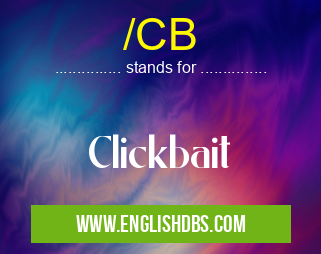What does /CB mean in TWITTER
Clickbait is a term used to describe a headline or post that attempt to draw readers in by appearing more exciting or sensational than the actual content. It is usually used on social media and online platforms, as it can often be used to drive clicks and increase website traffic. Clickbait usually promises more than it delivers, leaving readers feeling disappointed after clicking on the link.

/CB meaning in Twitter in Internet
/CB mostly used in an acronym Twitter in Category Internet that means Clickbait
Shorthand: /CB,
Full Form: Clickbait
For more information of "Clickbait", see the section below.
Definition
CB (or Clickbait) is a form of internet marketing that lures people in with headlines or posts that seem exciting but ultimately lack substance. It typically features provocative language, exaggerated claims, and sensationalized images in an effort to grab attention and drive engagement with the material. Once clicked, clickbait often fails to deliver on its promises and leaves readers feeling misled and unsatisfied with their experience.
Examples
One example of Clickbait can be seen in online news articles offering “shocking†stories about celebrities — such as “You won't believe what this celebrity just did!†While these stories may have some truth to them, they are often exaggerated for effect and generally lack any real substance. Another common example of CB is viral videos that make wild claims — such as “She tried this one strange trick and lost 50 pounds overnight!†In reality, these videos do not often provide any factual information or deliver results as promised.
Essential Questions and Answers on Clickbait in "INTERNET»TWITTER"
What is the difference between a clickbait and other online content?
Clickbait is typically any online content that utilizes sensationalized language in order to draw readers in and encourage them to click on the link. This technique can be used to drive traffic to websites and generate more clicks, views, or reactions. There are generally two types of clickbait - one which creates curiosity but never reveals an answer or resolution, and another which poses a question with an unexpected answer. Different from ordinary web content, clickbait uses vagueness and ambiguity to captivate the audience, instead of providing detail or context for the reader.
How can I identify clickbait?
Clickbait headlines often overemphasize promises or outcomes that sound too good to be true. They also tend to have exaggerated language like “shockingâ€, “incredible†and “amazingâ€, as well as emotionally charged language that plays on your feelings. It is important to be aware of these signs as they may indicate a clickbait article; clicking through may leave you feeling unsatisfied with not getting many answers to your questions!
Is there such a thing as “good†clickbait?
Yes, there is such thing as good clickbait. Good Clickbait posts use engaging headlines without false promises or vague solutions that just leave readers hanging. Quality content behind the headline should deliver on its promise with honest descriptions that give readers a clear understanding of what they will get out of it before clicking through.
Is it even possible for Clickbait posts to have accurate information?
It is possible for Clickbai posts to contain accurate information; however, this requires careful responsibility from both the writer and publisher when creating content. Accuracy must be included along with sensational headlines in order for readers to feel confident clicking through without feeling misled by misdirection alone.
Are all headlines written with a goal of attracting attention considered Clickbaits?
Not necessarily; some headlines simply highlight aspects of stories without promising anything outrageous or impossible - these do not qualify as clickbaits but still aim at garnering attention from the target audience so they can read the article further.
Why does Clickbaiting work so well?
Clickbaiting works because it relies on people's instinctive need for novelty, surprise and curiosity-provoking information - humans naturally gravitate towards sensationalized material because it is titillating and engaging on some level. The promise of getting "the inside scoop" or learning something new causes people to take a chance by clicking through links despite their doubts about accuracy or quality of content behind them.
How can I make sure my content isn't classified as Click bait?
To ensure your content isn't classified as click bait you should always focus on delivering quality over quantity by providing useful information rather than just catchy headlines that don't actually offer anything substantial upon further reading. Avoid using words like 'shocking', 'incredible' and 'amazing' unless they really reflect what you are offering in your post/article.
Final Words:
In conclusion, clickbait uses promising headlines or posts to draw readers in without delivering on its promises. It is frequently used across social media and other online platforms due to its ability to quickly generate clicks and drive traffic; however, it can also lead to disappointment among those who click through expecting something more substantial than what they get. It is important for users to be aware of clickbait tactics so they can avoid being fooled by them.
